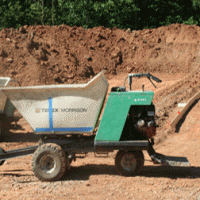When an operator is thrown from a ride-on vehicle when it tips over, such as a mud buggy, serious injury or death can result. In one such case we investigated, the issue centered on the maintenance of the vehicle, specifically whether a maladjusted hydrostatic drive caused the braking mechanism to malfunction.
A power buggy (sometimes called a mud buggy or Georgia buggy) is a very useful piece of construction equipment for hauling concrete, mortar, sand, gravel, etc. on a construction site. It is a high-capacity powered wheelbarrow; the operator may stand up as a rider on a fold-down platform, or may walk behind the vehicle during traveling with the load. The vehicle drive train is an air cooled gasoline engine and hydrostatic drive system. Powerful dynamic braking is provided via the hydrostatic drive; that is, when the operator releases the speed control handle to return to its neutral position, the hydraulic motors at the drive wheels act as pumps working against the backpressure allowed by a relief valve.
The heart of the hydrostatic drive is the pump, or transmission, which provides hydraulic flow to a single, or more typically, multiple hydraulic motors. The pump is a variable displacement device, accomplished by the tilt of a swash plate that changes the stroke of the radially configured cylinders. A single lever or pedal will control ground speed and braking, with a separate lever sometimes used for neutral, forward, and reverse. The braking action is accomplished when the swash plate is in its neutral position, so the pump cylinders are not stroked. If the swash plate is not adjusted to return to its neutral position when the speed control handle is released, the vehicle can creep in the opposite direction from the directional lever. The question for this case was whether such a maladjustment caused the dynamic braking action to be more severe than normal, resulting in extreme deceleration that caused the vehicle to tilt forward, ejecting the operator from his platform.
Testing of the braking action of a power buggy when the swash plate is properly adjusted vs. that of a buggy with a maladjusted swash plate required determining the reaction of the braking wheels at the precise instant of release of the speed control lever. This was accomplished by use of an audible signal to synchronize vehicle-mounted digital cameras trained on both the speed control lever and a wheel. A frame-by-frame comparison of the two videos allowed highly accurate conclusions, measured in microseconds.
Test results were validated by fitting the incident buggy and a number of exemplars with an outrigger to safely test the tip over potential under an number of different conditions, including different slopes of the travel surface, various engine speeds, various speed control lever positions, varying loads, varying load consistency (i.e., slosh-potential), and various swash plate adjustments. The testing showed there was no statistical difference in the brake performance, and thus tip over potential, for power buggies with correctly adjusted swash plates vs. those with maladjusted swash plates. It is the setting of the pressure relief that determines the amount of backpressure the drive motors must work against during braking that governs brake performance, rather than the swash plate adjustment.
Hydrostatic drives are used on many types of mobile and industrial equipment, including skid-steer loaders, landscaping equipment, track drives, conveyor drives, and construction equipment; testing similar to that described herein can be applied to all these equipment types.
Founded in 1997, The Warren Group, forensic engineers and consultants provides technical investigations and analysis of personal injury and property claims as well as expert testimony for insurance adjusters and attorneys. Extremely well versed in the disciplines of mechanical, electrical, chemical, structural, accident reconstruction and fire and explosion investigation, our engineers and consultants are known for delivering the truth — origin, cause, responsibility and cost of an event or claim — with unmistakable clarity.




